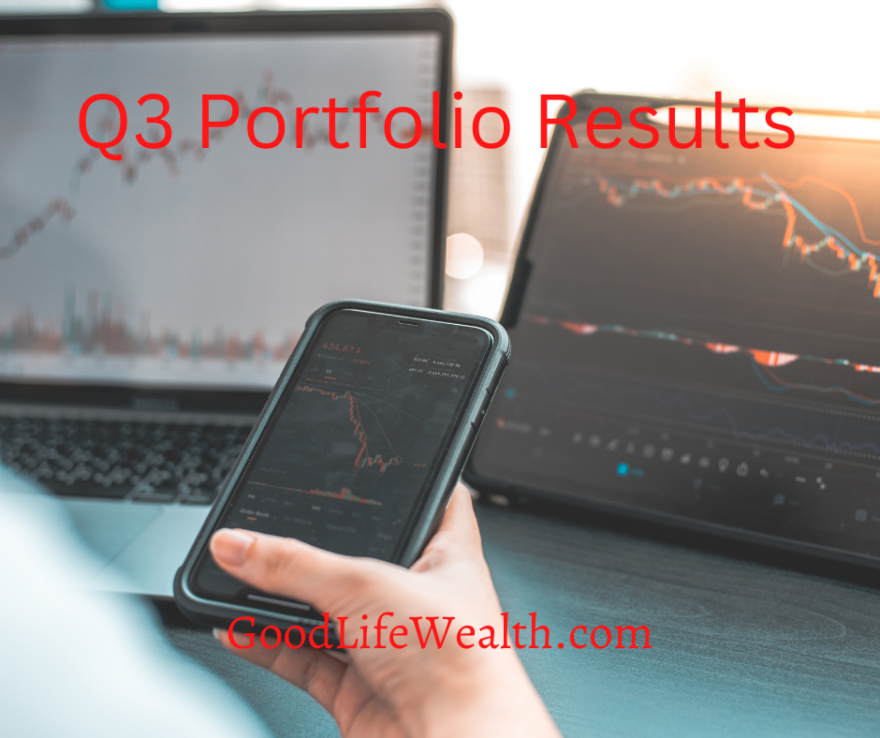Q3 Portfolio Results are in and no surprise, it’s ugly. Today we are going to dive into the numbers and give a realistic overview of the situation. More importantly, we are going to share some reasons for optimism, or at least patience. And we will discuss the remarkable situation being created from currencies and interest rates.
Market Returns YTD
We use two benchmarks to design and evaluate our portfolios. For stocks, we look at the MSCI World Index, using the ETF ticker ACWI. For bonds, we use the Barclays US Aggregate Bond Index, or AGG. Year to date through September 30, the total return of ACWI was -25.72% and the total return of AGG was -14.38. (Source: Morningstar.com)
Our portfolios are a blend of stocks and bonds. For example Moderate is 60/40, which has a benchmark of 60% stocks in ACWI and 40% bonds in AGG. Your hypothetical, benchmark returns YTD are as follows:
- Conservative 35/65: -18.35%
- Balanced 50/50: -20.05%
- Moderate 60/40: -21.18%
- Growth 70/30: -22.32%
- Aggressive 85/15: -24.02%
- Ultra Equity 100/00: -25.72%
Category Performance
This has been a difficult environment. We are doing a couple of points better than our benchmarks across our portfolios, net of fees. Our move to shorter duration bonds and floating rate at the beginning of the year was a positive. And our Value funds have lost less than the overall market. No doubt, it has been a tough year for investors and I am not happy with our results.
Q3 deepened the Bear Market in stocks and extended losses in bonds with rising interest rates. Commodities, which were up dramatically in Q1, reversed in Q3. Thankfully, we have been well positioned in our bonds which has been our primary area of defense.
International stocks are down more than US Stocks and this has detracted from our returns. A large component of the loss in International stocks is due to the currency exchange. The dollar is up 16% to the Euro, and the dollar is up 25% to the Japanese Yen. So, even if a European stock was flat on its price in Euros, it would be a 16% loss in dollars.
Don’t Time The Market
When the market is up, and I say that we don’t time the market, everyone nods in agreement. But when stocks are down 25%, even the steeliest investor may want to throw in the towel. It’s natural and it’s human nature. It’s also the worst thing an investor can do.
But Scott, this time is different!
The economic outlook is terrible. The Federal Reserve is determined to crush inflation regardless of the short-term pain it inflicts on the economy. The 30-year mortgage hit 7% this week. Corporate earnings are starting to decline and consumer confidence is plunging.
Yes, all this is true. But, the stock market is a leading indicator. Stocks move ahead of economic data and investors aim to predict what will happen. Even if markets are not perfectly efficient, it is possible that a lot of the future economic woes are already priced into stocks. Stocks typically rebound before we fully exit a recession.
I am not making light of the severity of the current market impact or the economic situation which faces the world. But when we see the historic graphs of when the stock market was down 25% and where it was a few years later, it is pretty obvious that we should to stay on course.
In fact, I have spent a lot of time kicking myself for not being more aggressive in March of 2020, when we had such an amazing buying opportunity. But these opportunities are only obvious in hindsight. In real time, these feel like horrible, painful times to be an investor. Selling didn’t work in 2002, 2008, or 2020. Those were years to stay invested, so you could recover in 2003, 2009, or the second half of 2020.
International Stocks Improving
Q3 has been especially tough for international stocks and they’ve fared even worse than US stocks. Shouldn’t we focus more on the high-quality US companies then? After all, the dollar continues to go up. Why fight that trend?
There are going to be future ramifications of the strong dollar. Besides that it’s a great time to go visit Europe or Japan, let’s think through the implications of a strong dollar. For US companies, a strong dollar hurts us. It makes our exports more expensive to the rest of the world. And it makes the foreign profits of US companies look smaller. (Almost half of the profits from the S&P 500 index comes from foreign sales.) Over time, a strong dollar will hurt the US stock market.
On the other hand, the strong dollar can benefit foreign companies. As US imports become more expensive, they can gain local market share. Their products are now cheaper to US consumers and we buy more imported goods. They sell more and have higher profits.
This creates a leveling mechanism where currencies may tend to pull back towards each other rather than continue to widen apart. A stronger dollar will help Europeans (including through our increased tourism), and those international companies will see their profits grow. When the dollar eventually weakens, that currency headwind will become a tailwind, pushing foreign stocks higher. I don’t know when the dollar will reverse, but based on their improving fundamentals, I don’t think now is the time to give up on international stocks.
No More ZIRP, Bye Bye TINA
In 2008, central banks reduced interest rates to zero to save the global economy. For the next 11 or so years, we had a Zero Interest Rate Policy, nicknamed ZIRP. The US had just begun to test the waters of moving up from 0%, when COVID-19 hit. And we went right back to 0% and piled on unprecedented stimulus to the economy.
The stimulus worked. It worked so well, in fact, that we created 8-10% inflation around the world this year. And so now, central banks are raising rates around the world. Last week, I wrote about being able to buy a 5% US government agency bond for the first time in over a decade. It’s a game changer.
For the past 14 years, 0% interest rates meant that There Is No Alternative to stocks. You simply could not invest in bonds. It became such a reality, that it became its own acronym. Like FOMO or LOL, every advisor knew TINA meant There Is No Alternative. Well, bye bye TINA, because bonds are back.
Bond yields are up and we can now buy high quality bonds with 4-6% yields. At those rates, we have a very real alternative to stocks. While we patiently wait for an eventual stock market recovery, we can buy attractive bonds right now. We are laddering our bonds from 1 through 5 years and will hold bonds to maturity. For clients with established withdrawals or Required Minimum Distributions, we are buying bonds to meet those needs over the next five years.
Discouraging but not Discouraged
Q3 has been rough, especially September. All the expectations about weak Septembers and mid-cycle election years certainly came true in 2022. I know the markets are incredibly disappointing right now, looking back over the last nine months. Both the stock and bond markets have double digit losses for 2022. I don’t think that has ever happened before and it means diversification hasn’t been much help.
We did make a few beneficial choices at the beginning of the year, with short-term bonds and Value stocks. Looking forward, there are reasons to be optimistic. Historically, after a 25% drop, stocks are usually higher 12 months later, and often see a double digit gain. Our international stocks have been hammered by the strong dollar. But that may ultimately be beneficial for foreign companies and the dollar may even reverse. Bonds yields are up and now there is a real alternative to stocks. (Can I coin TIARA, there is a real alternative? You heard it here first…)
No doubt these are frustrating times. I feel your pain and I am in the same boat, personally invested in our Aggressive Model. We’ve seen this before – Bear Markets in 2020, 2008, and 2000, and many before that. In fact, before 2000, Bear Markets were about once every four years. And one of three years in the market is down, historically. Every one of these drops feels unique and like the sky is falling. And in time, they work out eventually. I am looking at the markets daily and am ready to make adjustments. But sometimes, the sailor has to sail through the storm to reach their destination and it’s all part of the journey. We need patience, but also to keep asking questions and thinking long-term.





